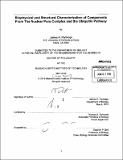Biophysical and structural characterization of components from the nuclear pore complex and the ubiquitin pathway
Author(s)
Partridge, James R. (James Robert)
DownloadFull printable version (17.14Mb)
Other Contributors
Massachusetts Institute of Technology. Dept. of Biology.
Advisor
Thomas U. Schwartz.
Terms of use
Metadata
Show full item recordAbstract
Formation of an endomembrane system in the eukaryotic cell is a hallmark of biological evolution. One such system is the nuclear envelope (NE), composed of an inner and outer membrane, used to form a nucleus and enclose the cell's genome. Access to the nucleus from the cytoplasm is mediated by a massive macromolecular machine called the nuclear pore complex (NPC). The NPC resides as a circular opening embedded in the NE and is composed of only -30 proteins that assemble with octagonal symmetry as biochemically defined subcomplexes to form the NPC. One such subcomplex is the Nspl / Nup62 complex, composed of three proteins and stabilized by coiled-coil interactions. Here we reconstitute a tetrameric assembly between the Nspl-complex and a fourth nucleoporin (Nup) Nic96. Nic96 harbors a 20 kDa coiled-coil domain at the N-terminus followed by a 65 kDa stacked helical domain. The coiled-coil domain of the Nspl -complex and the N-terminus of Nic96 combine to form a tetrameric assembly, integrated into the NPC lattice scaffold via the stacked helical domain of Nic96. We characterized the coiled-coil assembly with size exclusion chromatography and analytical ultracentrifugation. Deletion experiments and point mutations, directed by hydrophobic cluster analysis, were used to map connecting helices between members of the protein assembly. Although the core of the NPC is a rigid scaffold built for structural integrity, the NPC as a whole is a dynamic macromolecular machine. Protein transport is regulated by the small G protein Ran. Ran interacts with the NPC of metazoa via two asymmetrically localized components, Nupl53 at the nuclear face and Nup358 at the cytoplasmic face. Both Nups contain distinct RANBP2 type zinc finger (ZnF) domains. We present crystallographic data detailing the interaction between Nup1 53-ZnFs and RanGDP. A crystal-engineering approach led to well-diffracting crystals so that all ZnF-Ran complex structures are refined to high resolution. Each of the four zinc finger modules of Nup1 53 binds one Ran molecule in largely independent fashion. Nupl53-ZnFs bind RanGDP with higher affinity than RanGTP, however the modest difference suggests that this may not be physiologically meaningful. ZnFs may be used to concentrate Ran at the NPC to facilitate nucleocytoplasmic transport. In a separate study we present a structural analysis of the HECT domain from the E3 ubiquitin ligase HUWE1 and with biophysical data we show that an N-terminal helix stabilizes the HECT domain. This element modulates activity, as measured by self-ubiquitination induced in the absence of this helix, distinct from its effects on Ub conjugation of substrate Mcl-1. Such subtle structural elements in this domain potentially regulate the variable substrate specificity displayed by all HECT domain type, E3 ubiquitin ligases.
Description
Thesis (Ph. D.)--Massachusetts Institute of Technology, Dept. of Biology, 2010. Cataloged from PDF version of thesis. Includes bibliographical references (p. 136-151).
Date issued
2010Department
Massachusetts Institute of Technology. Department of BiologyPublisher
Massachusetts Institute of Technology
Keywords
Biology.